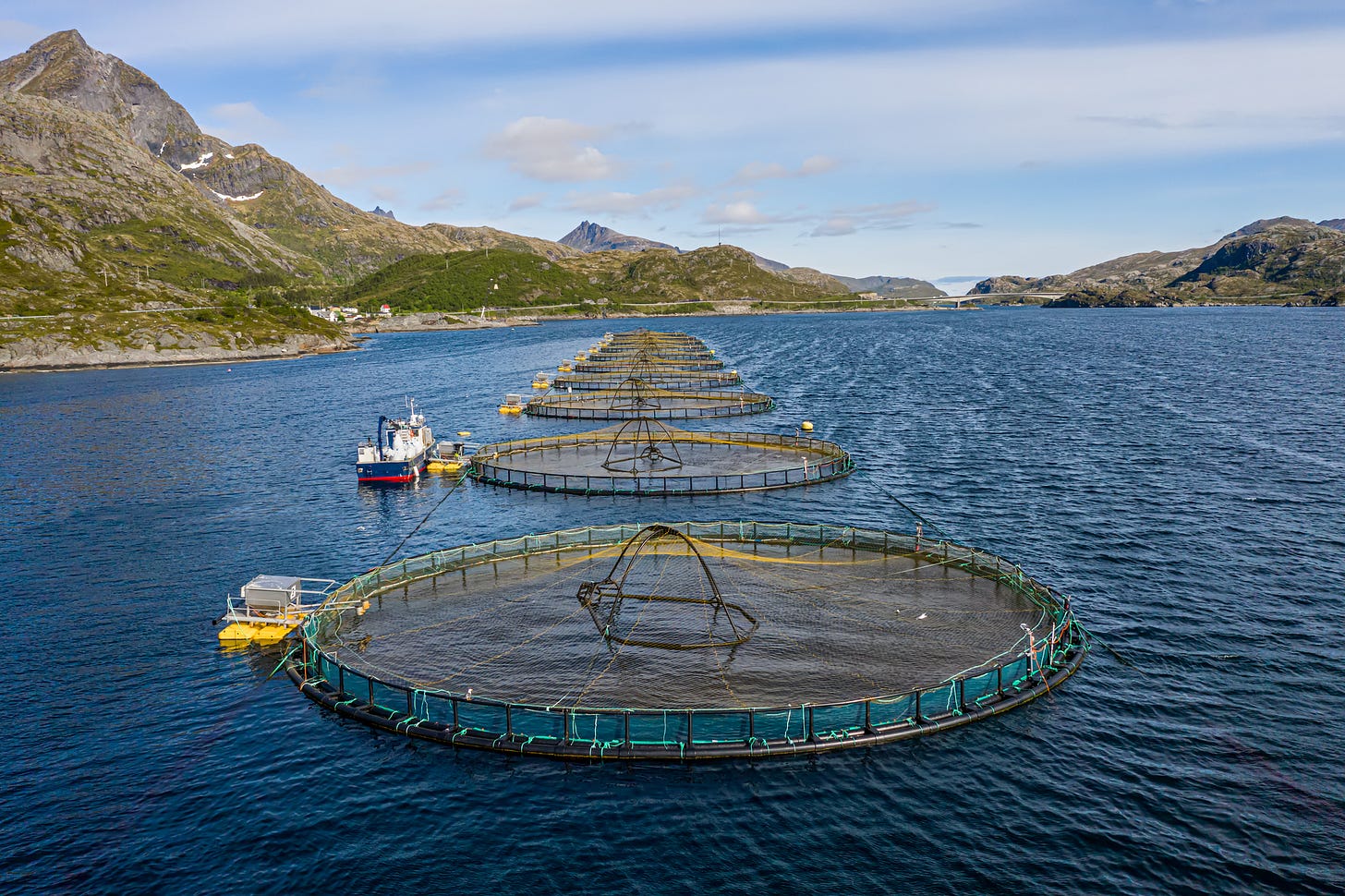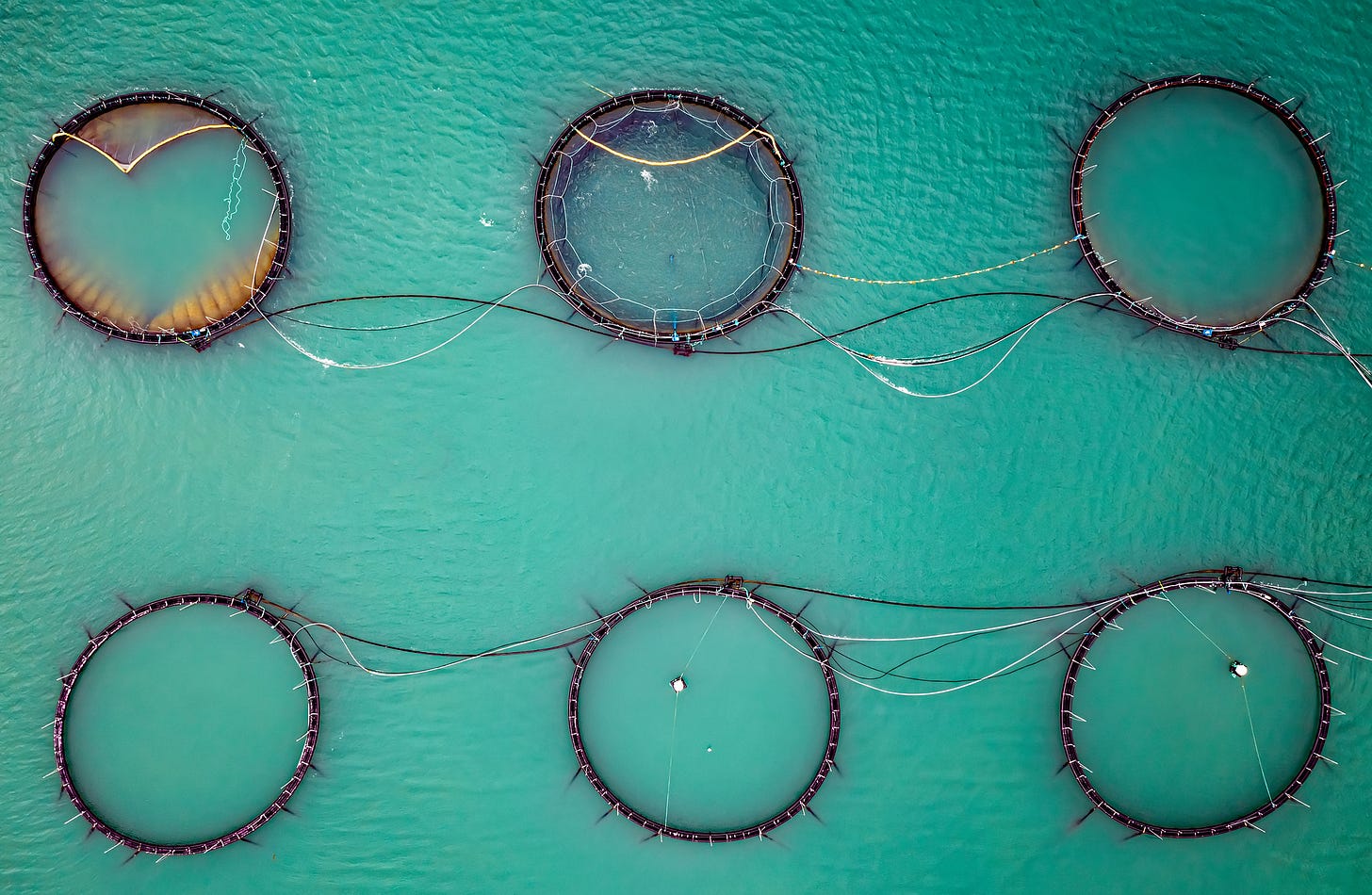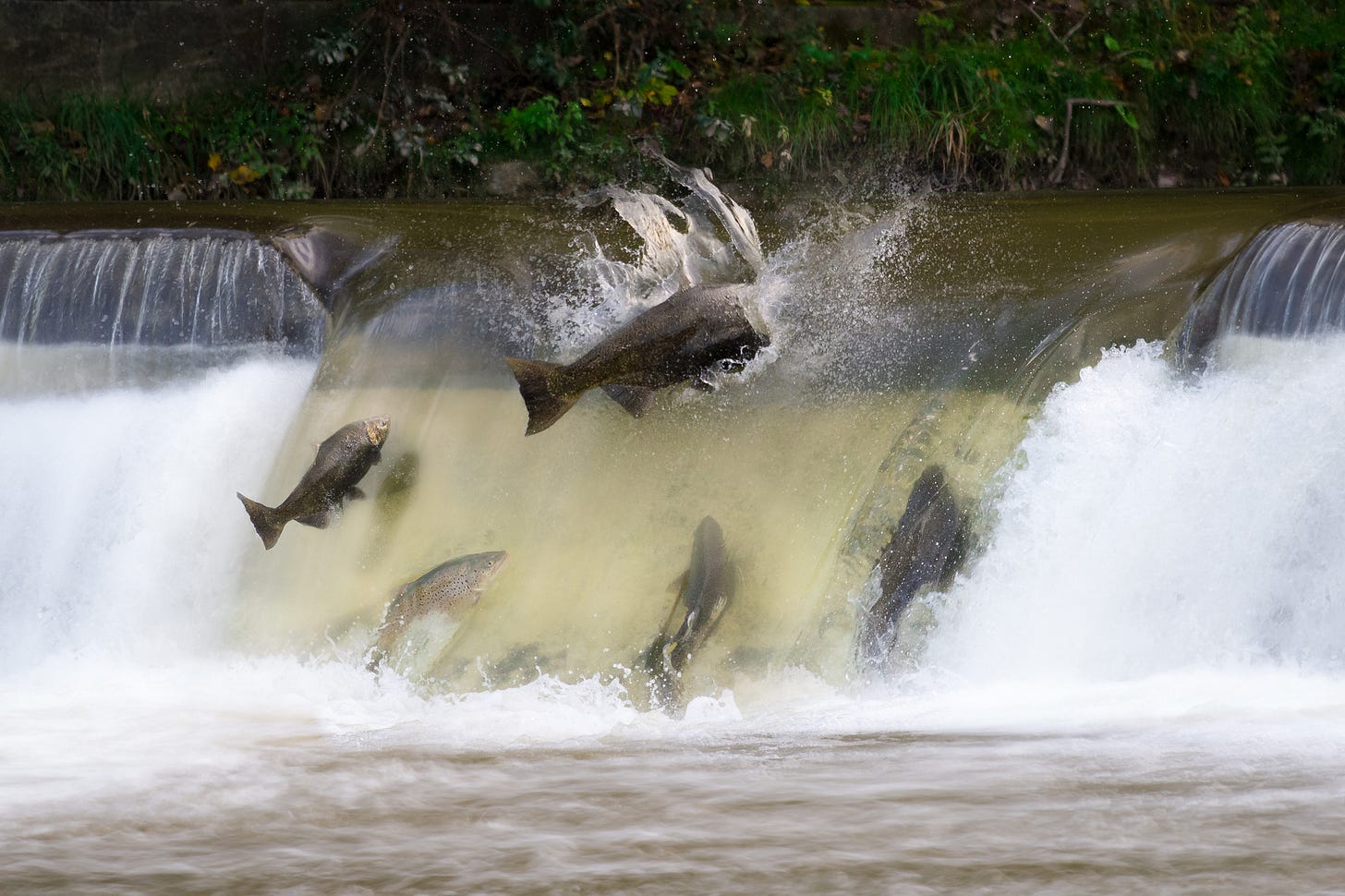EDITOR’S SUMMARY: Good fats (saturated), bad fats (hydrogenated), good carbs (organic berries), bad carbs (refined sugar), good protein (organic, pastured eggs), bad protein (meats cured w/ nitrites and antibiotics). Granted you may not agree, and it might not be so black and white; it’s a non-exhaustive, short list for sure. The point is that with most types of foods there is a spectrum of particulars to consider. Such is the case with salmon: farm-raised and wild are not “two peas in a pod.” On the contrary, they are quite different.
*This article was updated on 04-19-25 (see below).
You may be aware of the health benefits of including seafood into your diet. The American Heart Association recommends two 3.5 oz. servings of fish per week to help reduce the risk of heart disease and stroke, especially oily fish such as salmon.ᅠ
Salmon is rich in protein, heart healthy omega-3 fatty acids, and vitamin D. Because of the health benefits and the delicious taste, the rate of salmon consumption is rising fast; in fact, salmon is the most eaten fish in the United States. Over two pounds are consumed annually per person, and it ranks as the second most popular type of seafood, behind shrimp.
Have you wondered if it’s healthy to consume large quantities of salmon? The answer is “it depends.” It’s based on what kind of salmon you’re eating, and where and how it was raised. Regarding human health, there are notable differences between farmed-raised and wild salmon.
Salmon aquaculture—farming in water—is the fastest growing food production system in the world, accounting for 70 percent of the salmon sold globally. The salmon are sourced from a handful of large-scale factory farms, and swim inside seawater cages for up to two years before being harvested and processed. Hundreds of thousands, sometimes even millions of fish at a time are raised in high-density fish pens suspended in the ocean.ᅠ
Norway is the world’s leading producer of farmed salmon. The largest single species is Atlantic salmon, with global production of 2.89 million metric tons in 2021, up 6.8 percent from the previous year. The few other multinational salmon farm producers are found in Chile, Canada, and Scotland.
Toxic Swimmers: Impact On Your Health
To a greater or lesser degree, farmed salmon is contaminated. One of the most probable causes of contamination comes from their feed. Farmed salmon are fed from a global supply of processed pellets, made from fishmeal and fish oil, manufactured from small ocean fish.
Toxins build up in the oils of the fish, making it the source of a variety of contaminants, including heavy metals. Many European salmon farms get their fishmeal from fish dredged up from the Baltic sea, which is highly polluted. The fish are unfit for human consumption, so they end up in dry pellet fish food.
To add insult to injury, some farmers feed their salmon a plant-based diet consisting of genetically modified (GMO-laden) canola oil, soybean oil, corn, and other grains.
Other ingredients in salmon feed:
Dioxins and dioxin-like polychlorinated biphenyls (PCBs): Persistent organic pollutants (POPs). Dioxin and PCBs accumulate in fat, making it very hard to leave the body. Farmed salmon are intentionally fattened, and on average, contain 16 times the PCBs found in wild salmon.
These pollutants are linked to cancer, type-2 diabetes, obesity, and an increased risk of stroke. Farmed salmon also contain other persistent organic pollutants. In contrast, wild Alaskan salmon eat Pacific Ocean fish that are naturally low in PCB contamination.ᅠ
From the Environmental Working Group (EWG):
“These first-ever tests of farmed salmon from U.S. grocery stores show that farmed salmon are likely the most PCB-contaminated protein source in the U.S. food supply. On average farmed salmon have 16 times the dioxin-like PCBs found in wild salmon, 4 times the levels in beef, and 3.4 times the dioxin-like PCBs found in other seafood.”
Ethoxyquin: All farmed fish are contaminated with ethoxyquin. The manufacturer of ethoxyquin is Monsanto. While it used to be considered a pesticide, it's now thought of as a “synthetic antioxidant.” It’s added to the pellets to prevent the fat from going rancid. The levels aren’t regulated, and it could have ill effects on human health.
Antibiotics: Salmon feed is medicated with antibiotics in response to the presence of infectious diseases that plague farmed fish, due to overcrowded conditions. This leads to the growth of antibiotic-resistant bacteria. If the label on your salmon says “organic farmed,” it does not contain antibiotics. If antibiotics are used to treat the salmon, it cannot be sold with the organic label.
To be certified organic in the United States, fish must be fed organic foods only. Since there are no organic wild fish to feed the salmon, they can’t be truly organic. Clearly, the labeling of organic salmon is confusing. If you see salmon with an organic label, don’t be fooled, as there are indeed loopholes. It’s definitely farm-raised, possibly antibiotic-free, and may come from more “natural” waters.
Soybean oil: The omega-6 to omega-3 ratio in soybean oil is 8:1. Most people are deficient in omega-3 fatty acids. Americans consume an excess of omega-6 fats; mainly from processed foods and an abundance of rancid industrial seed oils. Soybean oil is not a natural part of a salmon’s diet, and as a result, physiological changes occur in salmon being fed soybean oil, including reduced levels of omega-3s.
In addition, from Science Daily, “America's most widely consumed oil causes genetic changes in the brain”:
“Used for fast food frying, added to packaged foods, and fed to livestock, soybean oil is by far the most widely produced and consumed edible oil in the U.S., according to the U.S. Department of Agriculture. In all likelihood, it is not healthy for humans.”
Added red dye: Wild caught salmon have pinkish-red flesh due to the krill they eat in their natural environment. Farmed salmon meat has a grayish, white color. To achieve the natural look, farmers use a synthetic chemical to dye the gray away.
From Time USA, in their Health Diet & Nutrition section, “How Farmers Turn Their Salmon Pink”
“One of the chemicals in carotenoids that gives salmon their red shade is called astaxanthin. It’s safe for customers to eat — according to the U.S. Food and Drug Administration, it can be included in salmon feed as long [as] it does not exceed 80 milligrams per kilogram and is used to enhance the pink, red or orange shade of the salmon, among other guidelines. Health food stores even sell astaxanthin in pill form as an antioxidant supplement for humans.”
Who’s measuring the astaxanthin, and to what extent do you trust the FDA’s assessment? Do your research.
Getting on Track With Omega-3 Fatty Acids
Farmed salmon and wild salmon both contain omega-3s. Because of the algae and plankton that wild salmon eat, some studies claim wild salmon have more omega-3 essential fatty acids. Others state that because farmed salmon have notably more fat (14.5–34%) than wild salmon (5–7%), they have higher amounts of omega-3 fatty acids.
Harvard Health Publishing, “Finding omega-3 fats in fish: Farmed versus wild,” states that both types seem to provide similar amounts of omega-3s per serving. What’s significant is that while both farmed-raised and wild salmon are high in omega-3s, the wild swimmers have less toxins stored in their fat.
In order for farmed salmon to be high in omega-3s, they must be fed fish oil, which is not only rich in omega-3s, but also contains pollutants. In addition, with the demand for fish oil outstripping supply, farmers are turning to vegetable oil for the fish feed. Consequently, the salmon that no longer consume the fish oil through their feed have lower levels of omega-3s (and vitamin D). The quality and quantity of omega-3s in salmon depends largely on the quality of food they’ve ingested.
The ratio between omega-6 and omega-3 fatty acids is significantly lower in wild salmon compared to farmed. The higher than ideal omega-6 to omega-3 ratio in farmed salmon can lead to an excess of omega-6s. Americans get plenty of omega-6s through the consumption of sunflower, corn, soybean, canola, and cottonseed oils. Too much omega-6 can cause health issues, such as inflammation and heart disease.
Dr. Chris Kresser had this to say in his article titled, “How Too Much Omega-6 and Not Enough Omega-3 Is Making Us Sick”:
“In plain english, what this means is that the more omega-3 fat you eat, the less omega-6 will be available to the tissues to produce inflammation. Omega-6 is pro-inflammatory, while omega-3 is neutral. A diet with a lot of omega-6 and not much omega-3 will increase inflammation. A diet of a lot of omega-3 and not much omega-6 will reduce inflammation.
Big Pharma is well aware of the effect of n-6 on inflammation. In fact, the way over-the-counter and prescription NSAIDs (ibuprofen, aspirin, Celebres, etc.) work is by reducing the formation of inflammatory compounds derived from n-6 fatty acids. (The same effect could be achieved by simply limiting dietary intake of n-6, as we will discuss below, but of course the drug companies don’t want you to know that. Less profit for them.)”
As for omega-3s … there’s plenty of research highlighting the health benefits. They’re essential nutrients for multiple cell functions, and play a significant role in the prevention of cardiovascular disease.
According to Cleveland Clinic, in “Omega-3 Fatty Acids”:
“Omega-3 fatty acids have many potential benefits for your cardiovascular health. One key benefit is that they help lower your triglyceride levels. Too many triglycerides in your blood (hypertriglyceridemia) raises your risk of atherosclerosis, and through this, can increase your risk of heart disease and stroke. So, it’s important to keep triglyceride levels under control. In addition, omega-3s may help you by raising your HDL (good) cholesterol and lowering your blood pressure.”
The Environment
In addition to the ill effects on human health, salmon farming has well-documented ecological hazards. Massive amounts of fish farm waste and toxic fish feed degrade marine life and pollute the environment. The drugs and chemicals used in factory fish farms cause great harm to the surrounding ecosystem.
These include the dioxins, pesticides, and antibiotics that are present in the fish feed. It also includes fertilizers, which fish farmers use to stimulate microscopic plant organisms. Just like too much fertilizer in your garden can have detrimental effects on your plants, the overuse of fertilizers in industrial fish farming can poison the local waterways, and eventually reach the ocean.
The conditions present at industrial fish farms stress the salmon—overcrowding, restricting access to the surface, and being handled. Not only can this influence their susceptibility to disease, it raises serious animal welfare concerns.
Considered a “salmon hero,” environmentalist Kurt Oddekalv said farmed salmon is one of the most toxic foods in the world. You can find his insider videos on how the salmon farming industry is destroying the natural environment.
Wild salmon—salmon swimming freely in our oceans, rivers, and lakes, are generally healthier, less contaminated, and more environmentally-friendly than their farmed counterparts. They eat various invertebrates and other organisms found in their natural habitat. This contributes to their high amounts of natural minerals, including calcium, iron, and potassium.
Most wild salmon in the market today were once swimming freely in the Pacific waters of Alaska. Wild species include Sockeye (most common), Chinook (King), Coho, Pink, and Chum. Devastatingly, in the last couple of years, Alaska has experienced incredibly low salmon runs.
Each year, salmon swim upstream, or “run” back to their place of creation where they spawn, and eventually die. The life cycle of each wild salmon species continues on. The reduced salmon runs in Alaska has led to a moratorium on fishing. What’s behind the salmon declines?
Scientists are looking at the warmer years of 2016–2019 resulting in reduced prey availability, and lower quality prey in their feeding grounds. Not only does this diminish the availability of wild salmon in Alaska, it affects the diet and livelihood of Indigenous Alaskans. Add to this (or perhaps “subtract”) the already depleted wild salmon, due to overfishing. As a result, many people are turning their forks to farmed salmon.
In the United States, the few remaining wild populations of Atlantic salmon are found in the Gulf of Maine. They’re endangered, and therefore prohibited to catch under the Endangered Species Act. Maine’s fishery has been shut down since 1948, so all of the Atlantic salmon available in the market today is from another country, and farmed.
*EDITOR’S UPDATE: 04-19-25
Regenerative Aquaculture: The Future of Fishery?
If you avoid conventionally farmed fish the way you steer clear of factory-farmed meat, dairy, and eggs, regenerative aquaculture offers an alternative you can stand behind. Think living reef, not industrial factory—this ecological, intentional practice is built on biodiversity and is flipping traditional fish farming on its head. James Arthur, founder of Seatopia, a regenerative aquafarm-to-table seafood subscription service, shares his perspective on the future of farming fish
“Regenerative aquaculture is just mimicking natural ecosystems—learning how to raise seafood in symbiotic relationships with biodiverse species.”
Conventional fish farms often rely on monocultures—single species raised in cramped, unsanitary conditions. Regenerative systems, by contrast, thrive on complexity. Fish, seaweed, and shellfish work together to clean the water, sequester carbon, and nourish one another. Rooted in biodiversity, this model mirrors the benefits of polyculture farming on land and offers a more sustainable, resilient, and ecologically sound approach.
At its core, regenerative aquaculture is a mindset grounded in ecological restoration. Whether in open-ocean systems where multiple species form nutrient-cycling communities, or in land-based, closed-loop farms that turn fish waste into fertilizer, regenerative designs are diverse by nature. The principles echo those of regenerative agriculture—favoring diversity over monoculture, restoration over extraction, and operational transparency. This approach not only produces healthier fish but also nurtures ecosystems, supports human health, and points toward a more environmentally responsible future.
Make Smart Salmon Purchasing Decisions
One idea is to balance your salmon consumption with other local seafood options. Because toxins build up in the fat of larger fish like salmon, choose smaller fish that are rich in omega-3s, such as sardines and anchovies.
Seek out alternative carnivorous fish such as mollusks. Mollusks have many nutritional benefits, are affordably priced, and their production is easier on the environment. Get additional types of healthy omega-3 fats from sources such as mackerel, cod liver oil, herring, flaxseed, hemp seeds, chia seeds, and walnuts.
Chat up your local fishmonger about the fish that is about to become your next meal, and ask the pertinent question—what do you have that’s local and wild? Read the labels at the grocery store. If it says “Atlantic,” or “Product of anywhere besides Alaska,” it’s likely farmed. If it reads “Pacific,” “Product of Alaska,” or the obvious, “Wild Caught,” it’s wild.
To minimize your risk of exposure to contaminants, trim off the skin, fat, and belly flap before cooking. It’s a catch-22, because the fat is where the highest levels of omega-3 fatty acids are found, but it’s also where most of the toxins are stored. So perhaps only cut off the fat if you’re eating farmed salmon.
Avoid frying salmon, as the PCB-laden fat can’t cook off. If you must eat farmed salmon, consider limiting your consumption to once or twice per month, and choose wild over farmed-raised whenever possible.
~
Originally published by A Voice For Choice Advocacy on May 4, 2023.
If you would like to support the research and health education of AVFC editorial, consider making a donation today.






